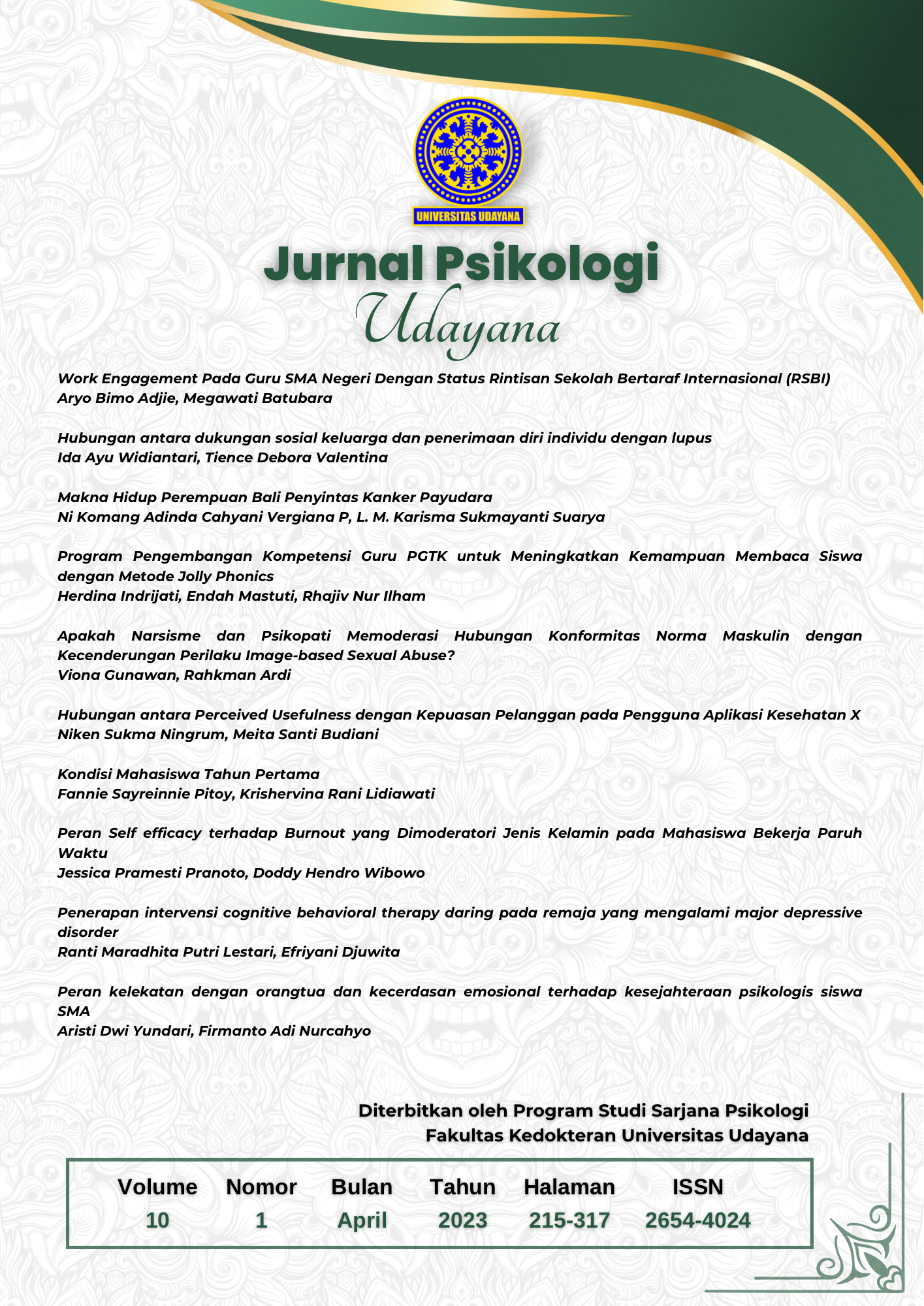Penerapan intervensi cognitive behavioral therapy daring pada remaja yang mengalami major depressive disorder
Abstract
Gejala depresi mengalami peningkatan selama masa remaja. Gejala depresi pada remaja menyebabkan gangguan pada berbagai fungsi kehidupan hingga dapat menjadi penyebab perilaku bunuh diri. Dengan demikian, perlu untuk dilakukan penanganan yang tepat dan komprehensif pada remaja yang mengalami depresi, salah satunya menggunakan pendekatan Cognitive Behavioral Therapy (CBT). Penelitian ini bertujuan untuk mengetahui efektifitas intervensi cognitive behavioral therapy secara daring pada remaja yang mengalami major depressive disorder (MDD). Partisipan dalam penelitian ini adalah seorang remaja perempuan berusia 17 tahun 10 bulan yang menurut hasil pemeriksaan psikologis memenuhi kriteria diagnosa MDD. Desain dalam penelitian ini adalah single-case experimental design. Intervensi terdiri dari 1 sesi pra-intervensi, 7 sesi inti, 2 sesi pasca, serta sesi follow up. Data hasil intervensi dianalisis secara kuantitatif dan kualitatif. Secara kuantitatif, dilakukan perbandingan skor dari alat ukur Beck Depression Inventory (BDI) – II yang diberikan pada saat sebelum dan sesudah intervensi. Secara kualitatif, keefektivitasan intervensi dilihat melalui hasil wawancara. Hasil menunjukkan bahwa secara kuantitatif terdapat penurunan tingkat depresi dari moderate depression menjadi ups and downs normal setelah intervensi dilakukan. Secara kualitatif, partisipan merasakan banyak manfaat dari intervensi yang dilakukan, salah satunya memahami kekeliruan berpikirnya dan lebih mampu melihat suatu hal dari berbagai sudut pandang. Dengan demikian, program intervensi CBT secara daring efektif untuk mengurangi gejala depresi pada remaja yang mengalami MDD.
Downloads
References
Bardone, A. M., Moffitt, T. E., Caspi, A., Dickson, N., Stanton, W. R., Silva, P. A. (1998). Adult physical health outcomes of adolescent girls with conduct disorder, depression, and anxiety. J Am Acad Child Adolesc Psychiatry. 37, 594–601.
Chen, X., He, J., Xitao Fan, & Cai, Z. (2021). Attachments, dispositional mindfulness, and psychological distress: A mediation analysis. Current Psychology, 40(4), 1651–1659. https://doi.org/10.1007/s12144-018-0088-0
Harrington R., Pickles A., Aglan A., Harrington V., Burroughs H., Kerfoot M. (2006) Early adult outcomes of adolescents who deliberately poisoned themselves. J Am Acad Child Adolesc Psychiatry. 45, 337–345.
Kim-Cohen, J., Caspi, A., Moffitt, T. E., Harrington, H., Milne, B. J., Poulton, R. (2003). Prior juvenile diagnoses in adults with mental disorder: developmental follow-back of a prospective-longitudinal cohort. Arch Gen Psychiatry. 60, 709–717.
Mash, E. J., Wolfe, D. A. (2016). Abnormal Child Psychology (6th Eds.). USA: Cengage Learning.
Milne, L. C., & Lancaster, S. (2001). Predictors of depression in female adolescents. Adolescence, 36(142), 207–223.
Papalia, D. E., & Martorell, G. (2021). Experience human development (Fourteenth edition). McGraw-Hill Education.
Rosselló, J., Bernal, G., & Piedras, R. (2007). Treatment Manual For Cognitive Behavioral Therapy For Depression 1.
Santrock, J. W. (2019). Life-span development (Seventeenth edition). McGraw-Hill Education.
Spirito, A., Esposito-Smythers, C., Wolff, J., & Uhl, K. (2011). Cognitive-Behavioral Therapy for Adolescent Depression and Suicidality. Child and Adolescent Psychiatric Clinics of North America, 20(2), 191–204.
https://doi.org/10.1016/j.chc.2011.01.012
Stallard, P. (2005). A Clinician’s Guide to Think Good - Feel Good: Using CBT with Children and Young People. England: John Wiley & Sons, Ltd.
Stallard, P., Richardson, T., Velleman, S., & Attwood, M. (2011). Computerized CBT (Think, Feel, Do) for Depression and Anxiety in Children and Adolescents: Outcomes and Feedback from a Pilot Randomized Controlled Trial. Behavioural and
Cognitive Psychotherapy, 39(3), 273–284. https://doi.org/10.1017/S135246581000086X
Taylor, T. L., & Montgomery P. (2007). Can cognitive-behavioral therapy increase self esteem among depressed adolescents? A systematic review. Children and Youth Services Reviews, 29(7), 823-839.
Thapar, A., Collishaw, S., Pine, D. S., & Thapar, A. K. (2012). Depression in adolescence. The Lancet, 379(9820), 1056–1067. https://doi.org/10.1016/S0140-6736(11)60871-4
Watanabe, N., Hunot, V., Omori, I. M., Churchill, R., & Furukawa, T. A. (2007). Psychotherapy for depression among children and adolescents: a systematic review. Acta Psychiatrica Scandinavica, 116(2), 84–95. doi:10.1111/j.1600-0447.2007.01018.x
Wright, B., Tindall, L., Littlewood, E., Allgar, V., Abeles, P., Trépel, D., & Ali, S. (2017). Computerised cognitive–behavioural therapy for depression in adolescents: feasibility results and 4-month outcomes of a UK randomised controlled trial. BMJ Open, 7(1), e012834.doi:10.1136/bmjopen-2016-012834
Zamorano, C., & Rojas, C. (2017). Adolescent Self-cutting: An Embodiment of the Unsaid. Australian and New Zealand Journal of Family Therapy, 38(3), 317–328. https://doi.org/10.1002/anzf.1240

This work is licensed under a Creative Commons Attribution-ShareAlike 4.0 International License.
Authors who publish with this journal agree to the following terms:
- Authors retain copyright and grant the journal right of first publication with the work simultaneously licensed under a Creative Commons Attribution-ShareAlike 4.0 International License that allows others to share the work with an acknowledgement of the works authorship and initial publication in this journal.
- Authors are able to enter into separate, additional contractual arrangements for the non-exclusive distribution of the journals published version of the work (e.g., post it to an institutional repository or publish it in a book), with an acknowledgement of its initial publication in this journal.
- Authors are permitted and encouraged to post their work online (e.g., in institutional repositories or on their website) prior to and during the submission process, as it can lead to productive exchanges, as well as earlier and greater citation of published work (See The Effect of Open Access).













